LearnedAmateur
National Hazard
   
Posts: 513
Registered: 30-3-2017
Location: Somewhere in the UK
Member Is Offline
Mood: Free Radical
|
|
Unidentified gunk on sodium in white spirit
I've just dug out my chunk of sodium to give it a little inspection and I thought I'd ask to see what this strange red 'gel' is. I've known about it
since it started forming a couple of months after I bought the chunk, which was about a year and a half to two years ago. I store it in a regular jam
jar with a screw on aluminium top, it has leaked over time because the level of white spirit is down a third to a half but the metal itself is still
quite lustrous so not much air has penetrated the solvent. The WS I'm using states 'Aliphatic hydrocarbons - 30% and more & aromatic hydrocarbons
- 15% or over but less than 30%' and also mentions that it 'contains naphtha hydrosulfurized heavy'. I have suspicions that it's the superoxide due to
its colour but it could be something else, here's a picture (the flash seems to have lightened it slightly, the colour is more of a blend between rust
and orange juice).
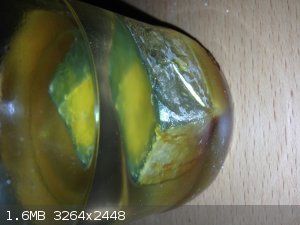
[Edited on 7-11-2017 by LearnedAmateur]
In chemistry, sometimes the solution is the problem.
It’s been a while, but I’m not dead! Updated 7/1/2020. Shout out to Aga, we got along well.
|
|
|
vmelkon
National Hazard
   
Posts: 669
Registered: 25-11-2011
Location: Canada
Member Is Offline
Mood: autoerotic asphyxiation
|
|
Possibly caused by aldol condensation.
This can happen if you have a ketone, such as acetone, and a aldehyde, such as benzaldehyde or acetaldehyde, and they react under alkaline conditions.
How does the stuff react with water?
Signature ==== Is this my youtube page? https://www.youtube.com/watch?v=tA5PYtul5aU
We must attach the electrodes of knowledge to the nipples of ignorance and give a few good jolts.
Yes my evolutionary friends. We are all homos here. |
|
|
LearnedAmateur
National Hazard
   
Posts: 513
Registered: 30-3-2017
Location: Somewhere in the UK
Member Is Offline
Mood: Free Radical
|
|
The substance dissolves somewhat in water, turning to a light, cloudy yellow solution. With pH paper, the solution gives a value above 11, so I'm
expecting some hydroxide to have formed. Adding saturated copper nitrate solution, the yellow colour disappears and a gelatinous precipitate of copper
hydroxide drops out.
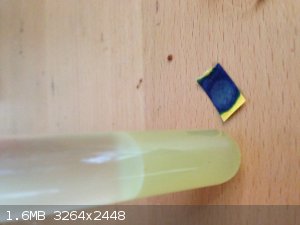 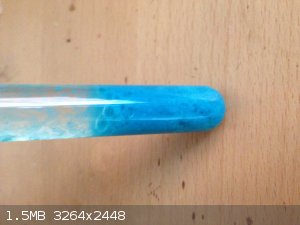
[Edited on 9-11-2017 by LearnedAmateur]
In chemistry, sometimes the solution is the problem.
It’s been a while, but I’m not dead! Updated 7/1/2020. Shout out to Aga, we got along well.
|
|
|
nezza
Hazard to Others
  
Posts: 324
Registered: 17-4-2011
Location: UK
Member Is Offline
Mood: phosphorescent
|
|
Alkali metals are just such fun to store long term. I have small samples of Lithium, Sodium and Potassium I have in an element collection. THe
Potassium is stored in dried mineral oil under Argon and the oil still forms a yellow gel after a few months. The potassium does not have an oxide
coat as the metal is clean and the small sphere in the picture has a crystalline appearance.
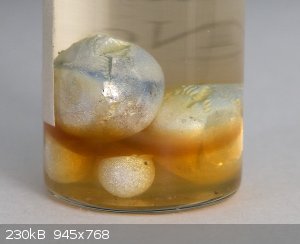
If you're not part of the solution, you're part of the precipitate.
|
|
|
LearnedAmateur
National Hazard
   
Posts: 513
Registered: 30-3-2017
Location: Somewhere in the UK
Member Is Offline
Mood: Free Radical
|
|
I've always preferred potassium to sodium, it looks a lot prettier for one, but I got sodium because it's so much cheaper and readily available. Seems
like it's the same anion responsible because that's the exact colour of my contaminant and my sodium doesn't have any notable corrosion either.
Although I do have quite a bright red patch on the underside of the chunk and it is somewhat whitish, a microscopic layer of oxide/hydroxide but just
look at the contrast with the (shaken) yellow precipitate.
Oh yeah, I'm going to test the stuff again, this time with MnO2. If it is the superoxide or peroxide, they react with water to form hydrogen peroxide
so oxygen bubbles will be the giveaway.
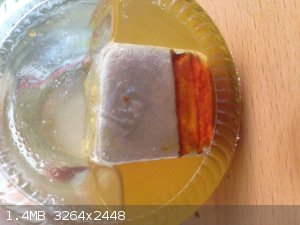
[Edited on 10-11-2017 by LearnedAmateur]
In chemistry, sometimes the solution is the problem.
It’s been a while, but I’m not dead! Updated 7/1/2020. Shout out to Aga, we got along well.
|
|
|